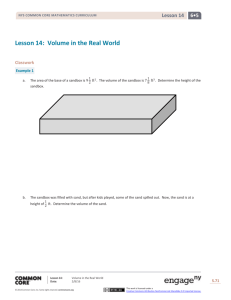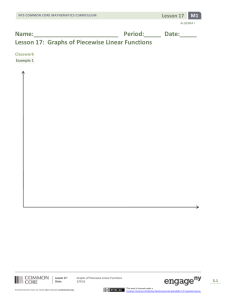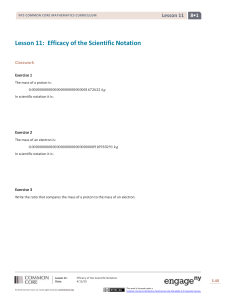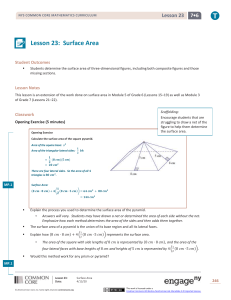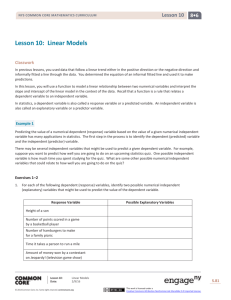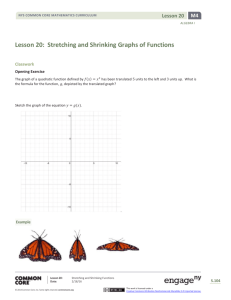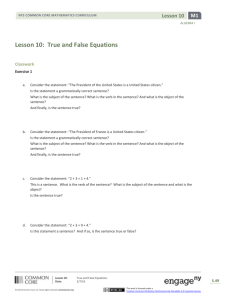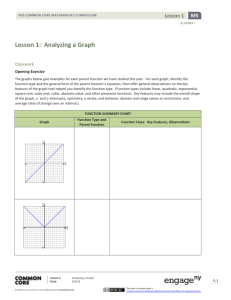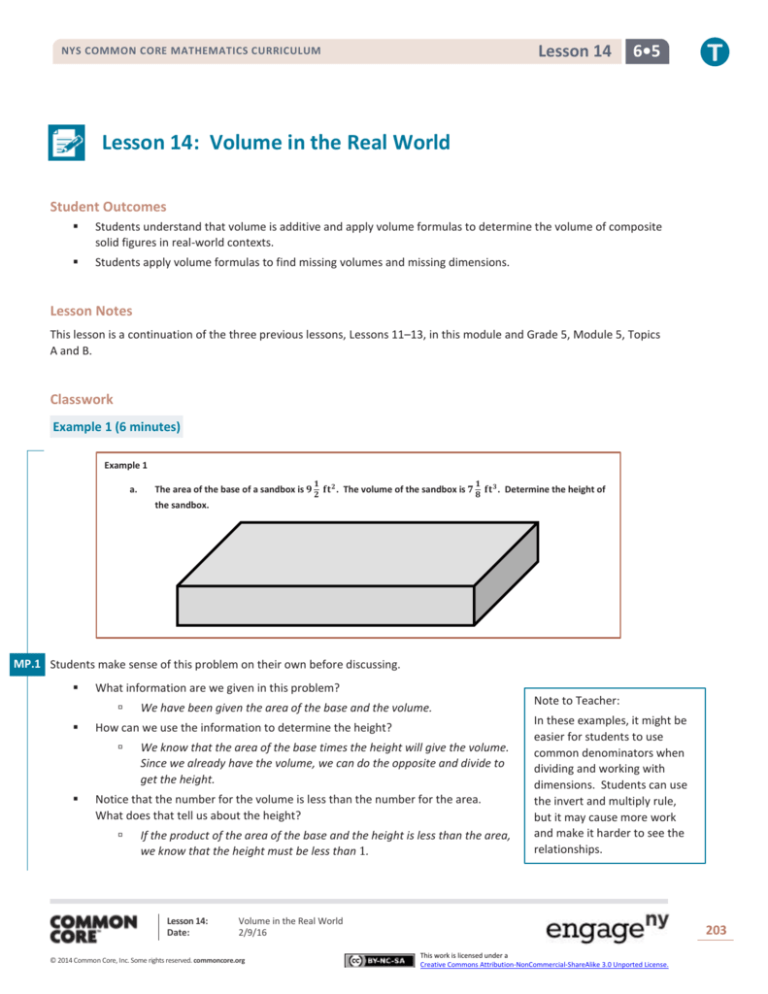
Lesson 14
NYS COMMON CORE MATHEMATICS CURRICULUM
6•5
Lesson 14: Volume in the Real World
Student Outcomes
Students understand that volume is additive and apply volume formulas to determine the volume of composite
solid figures in real-world contexts.
Students apply volume formulas to find missing volumes and missing dimensions.
Lesson Notes
This lesson is a continuation of the three previous lessons, Lessons 11–13, in this module and Grade 5, Module 5, Topics
A and B.
Classwork
Example 1 (6 minutes)
Example 1
a.
The area of the base of a sandbox is 𝟗
𝟏 𝟐
𝟏
𝐟𝐭 . The volume of the sandbox is 𝟕 𝐟𝐭 𝟑 . Determine the height of
𝟐
𝟖
the sandbox.
MP.1 Students make sense of this problem on their own before discussing.
What information are we given in this problem?
How can we use the information to determine the height?
We have been given the area of the base and the volume.
We know that the area of the base times the height will give the volume.
Since we already have the volume, we can do the opposite and divide to
get the height.
Notice that the number for the volume is less than the number for the area.
What does that tell us about the height?
If the product of the area of the base and the height is less than the area,
we know that the height must be less than 1.
Lesson 14:
Date:
Note to Teacher:
In these examples, it might be
easier for students to use
common denominators when
dividing and working with
dimensions. Students can use
the invert and multiply rule,
but it may cause more work
and make it harder to see the
relationships.
Volume in the Real World
2/9/16
© 2014 Common Core, Inc. Some rights reserved. commoncore.org
203
This work is licensed under a
Creative Commons Attribution-NonCommercial-ShareAlike 3.0 Unported License.
Lesson 14
NYS COMMON CORE MATHEMATICS CURRICULUM
6•5
Calculate the height.
Volume = Area of the base × height
𝑉 = 𝑏ℎ
1 3
1
ft = (9 ft 2 ) ℎ
8
2
57 3
19 2
ft = (
ft ) ℎ
8
2
57 3 2
19
2 2
ft ×
=
×(
ft ) ℎ
8
19
2
19
114
3
ft. = ℎ or ft. = ℎ
152
4
7
MP.1
b.
The sandbox was filled with sand, but after kids played, some of the sand spilled out. Now, the sand is at a
height of
What new information have we been given in this problem?
𝟏
𝐟𝐭. Determine the volume of the sand.
𝟐
This means that the sandbox is not totally filled. Therefore, the volume of sand used is not the same as
the volume of the sandbox.
How will we determine the volume of the sand?
To determine the volume of the sand, I will use the area of the base of the sand box, but I will use the
height of
1
2
ft. instead of the height of the sandbox.
Volume = Area of the base × height
1 2 1
ft × ft.
2
2
19 2 1
Volume =
ft × ft.
2
2
19 3
Volume =
ft
4
3
Volume = 4 ft 3
4
Volume = 9
3
The volume of the sand is 4 ft 3 .
4
Lesson 14:
Date:
Volume in the Real World
2/9/16
© 2014 Common Core, Inc. Some rights reserved. commoncore.org
204
This work is licensed under a
Creative Commons Attribution-NonCommercial-ShareAlike 3.0 Unported License.
Lesson 14
NYS COMMON CORE MATHEMATICS CURRICULUM
6•5
Example 2 (6 minutes)
Example 2
A special order sandbox has been created for children to use as an archeological digging area at the zoo. Determine the
volume of the sandbox.
𝟓𝐦
𝟐𝐦
𝟏
𝐦
𝟓
𝟐
𝟏
𝐦
𝟑
𝟑
𝟐 𝐦
𝟒
𝟒
𝟏
𝐦
𝟑
𝟏
𝟐 𝐦
𝟒
Describe this three-dimensional figure.
This figure looks like two rectangular prisms that have been placed together to form one large prism.
I could think of it as a piece on the left and a piece on the right.
Or, I could think of it as a piece in front and a piece behind.
MP.7
How can we determine the volume of this figure?
Does it matter which way we divide the shape when we calculate the volume?
We can find the volume of each piece and then add the volumes together to get the volume of the
entire figure.
Answers will vary.
At this point, you can divide the class in half and have each half determine the volume using one of the
described methods.
If the shape is divided into a figure on the left and a figure on the right, we would have the following:
Volume of prism on the left = 𝑙 𝑤 ℎ.
3
1
𝑉 =2 m×2m× m
4
5
11
1
𝑉=
m×2m× m
4
5
𝑉=
22 3
m
20
Lesson 14:
Date:
Volume in the Real World
2/9/16
© 2014 Common Core, Inc. Some rights reserved. commoncore.org
205
This work is licensed under a
Creative Commons Attribution-NonCommercial-ShareAlike 3.0 Unported License.
Lesson 14
NYS COMMON CORE MATHEMATICS CURRICULUM
6•5
Volume of the prism on the right = 𝑙 𝑤 ℎ.
1
1
1
𝑉 =2 m×4 m× m
4
3
5
9
13
1
𝑉 = m×
m× m
4
3
5
117 3
𝑉=
m
60
39 3
𝑉=
m
20
Total volume = volume of left + volume of right
22 3 39 3
m +
m
20
20
61 3
1
Total volume =
m =3
m3
20
20
Total volume =
If the shape is divided into a figure with a piece in front and piece behind, we have the following:
Volume of the back piece = 𝑙 𝑤 ℎ
1
𝑉 =5m×2m× m
5
𝑉 = 2 m3
Volume of the front piece = 𝑙 𝑤 ℎ
1
1
1
𝑉 =2 m×2 m× m
4
3
5
9
7
1
𝑉 = m× m× m
4
3
5
63 3
3
1 3
𝑉=
m =1
m3 = 1
m
60
60
20
Total volume = volume of back + volume of front
1
Total volume = 2 m3 + 1
m3
20
1 3
Total volume = 3
m
20
What do you notice about the volumes determined in each method?
The volume calculated with each method is the same. It does not matter how we break up the shape.
We will still get the same volume.
Lesson 14:
Date:
Volume in the Real World
2/9/16
© 2014 Common Core, Inc. Some rights reserved. commoncore.org
206
This work is licensed under a
Creative Commons Attribution-NonCommercial-ShareAlike 3.0 Unported License.
Lesson 14
NYS COMMON CORE MATHEMATICS CURRICULUM
6•5
Exercises (20 minutes)
Students work in pairs. When working with composite figures, have one student solve using one method and the other
solve the problem another way so they can compare answers.
Exercises
1.
a.
The volume of the rectangular prism is given. Determine the missing measurement using a one-step
equation.
𝑽 = 𝑩𝒉
𝟑𝟔
𝟒
= ( )𝒉
𝟏𝟓
𝟓
𝟑𝟔 𝟓
𝟒 𝟓
× = ( )( )𝒉
𝟏𝟓 𝟒
𝟓 𝟒
𝟏𝟖𝟎
=𝒉
𝟔𝟎
𝟑=𝒉
𝐀𝐫𝐞𝐚 =
𝑽=
𝟑𝟔
𝐲𝐝𝟑
𝟏𝟓
𝟒
𝐲𝐝𝟐
𝟓
𝒉=?
The height is 𝟑 𝐲𝐝.
b.
The volume of the box is
𝟒𝟓
𝐦𝟑. Determine the area of the base using a one-step equation.
𝟔
𝑽 = 𝑩𝒉
𝟒𝟓
𝟗
= 𝑩( )
𝟔
𝟐
𝟒𝟓 𝟐
𝟗 𝟐
( )( ) = 𝑩( )( )
𝟔 𝟗
𝟐 𝟗
𝟗𝟎
=𝑩
𝟓𝟒
𝟓
=𝑩
𝟑
The area is
2.
𝟓
𝟑
𝟗
𝐦
𝟐
𝐦𝟐 .
Marissa’s fish tank needs to be filled with more water.
a.
Determine how much water the tank can hold.
𝐕𝐨𝐥𝐮𝐦𝐞 𝐨𝐟 𝐞𝐧𝐭𝐢𝐫𝐞 𝐭𝐚𝐧𝐤 = 𝒍 𝒘 𝒉
𝟑
𝟏
𝟑
𝑽 = ( 𝐦) ( 𝐦) ( 𝐦)
𝟒
𝟒
𝟓
𝟗
𝟑
𝑽=
𝐦
𝟖𝟎
b.
Determine how much water is already in the tank.
𝐕𝐨𝐥𝐮𝐦𝐞 𝐨𝐟 𝐰𝐚𝐭𝐞𝐫 𝐢𝐧 𝐭𝐡𝐞 𝐭𝐚𝐧𝐤 = 𝒍 𝒘 𝒉
𝟑
𝐦
𝟓
𝟑
𝐦
𝟖
𝟑
𝐦
𝟒
𝟏
𝐦
𝟒
𝟑
𝟏
𝟑
𝑽 = ( 𝐦) ( 𝐦) ( 𝐦)
𝟒
𝟒
𝟖
𝟗
𝟐
𝑽=
𝐦
𝟏𝟐𝟖
Lesson 14:
Date:
Volume in the Real World
2/9/16
© 2014 Common Core, Inc. Some rights reserved. commoncore.org
207
This work is licensed under a
Creative Commons Attribution-NonCommercial-ShareAlike 3.0 Unported License.
Lesson 14
NYS COMMON CORE MATHEMATICS CURRICULUM
c.
6•5
How much more water is needed to fill the tank?
Height of empty part of tank:
𝒉=
𝟑
𝟑
𝟐𝟒
𝟏𝟓
𝟗
𝐦− 𝐦=
𝐦−
𝐦=
𝐦
𝟓
𝟖
𝟒𝟎
𝟒𝟎
𝟒𝟎
𝐕𝐨𝐥𝐮𝐦𝐞 𝐧𝐞𝐞𝐝𝐞𝐝 𝐭𝐨 𝐟𝐢𝐥𝐥 = 𝒍 𝒘 𝒉
𝟑
𝟏
𝟗
𝑽 = ( 𝐦) ( 𝐦) (
𝐦)
𝟒
𝟒
𝟒𝟎
𝟐𝟕
𝑽=
𝐦𝟑
𝟔𝟒𝟎
3.
Determine the volume of the composite figures.
a.
𝟑
𝟏𝟐 𝐦
𝟐
𝟗
𝟏
𝐦
𝟐
𝟏
𝐦
𝟒
𝟏
𝐦
𝟑
𝟐𝐦
𝐕𝐨𝐥𝐮𝐦𝐞 𝐨𝐟 𝐥𝐞𝐟𝐭 𝐩𝐢𝐞𝐜𝐞 = 𝒍 𝒘 𝒉
𝟏
𝑽 = (𝟐 𝐦)(𝟏𝟐 𝐦) (𝟑 𝐦)
𝟒
𝟏𝟑
(𝟐
𝑽=
𝐦)(𝟏𝟐 𝐦) (
𝐦)
𝟒
𝟏
𝟏
𝟏
𝐦) (𝟐 𝐦) (𝟑 𝐦)
𝟐
𝟑
𝟒
𝟏𝟗
𝟕
𝟏𝟑
𝑽=(
𝐦) ( 𝐦) (
𝐦)
𝟐
𝟑
𝟒
𝟏𝟕𝟐𝟗 𝟑
𝟏
𝑽=
𝐦 = 𝟕𝟐
𝐦𝟑
𝟐𝟒
𝟐𝟒
𝑽 = (𝟗
𝑽 = 𝟕𝟖 𝐦𝟑
𝐓𝐨𝐭𝐚𝐥 𝐯𝐨𝐥𝐮𝐦𝐞 = 𝟕𝟖 𝐦𝟑 + 𝟕𝟐
Lesson 14:
Date:
𝐕𝐨𝐥𝐮𝐦𝐞 𝐨𝐟 𝐛𝐚𝐜𝐤 𝐫𝐢𝐠𝐡𝐭 = 𝒍 𝒘 𝒉
𝟏
𝟏
𝐦𝟑 = 𝟏𝟓𝟎
𝐦𝟑
𝟐𝟒
𝟐𝟒
Volume in the Real World
2/9/16
© 2014 Common Core, Inc. Some rights reserved. commoncore.org
208
This work is licensed under a
Creative Commons Attribution-NonCommercial-ShareAlike 3.0 Unported License.
Lesson 14
NYS COMMON CORE MATHEMATICS CURRICULUM
b.
𝟏
𝟏
𝐟𝐭.
𝟐
𝟏
𝐟𝐭.
𝟐
𝟏
𝐟𝐭.
𝟐
𝟑
𝐟𝐭.
𝟒
𝟏
𝐟𝐭.
𝟒
𝟏
𝟏
𝐟𝐭.
𝟐
𝐕𝐨𝐥𝐮𝐦𝐞 𝐨𝐟 𝐥𝐨𝐧𝐠 𝐛𝐚𝐜𝐤 𝐩𝐢𝐞𝐜𝐞 = 𝒍 𝒘 𝒉
𝐕𝐨𝐥𝐮𝐦𝐞 𝐨𝐟 𝐦𝐢𝐝𝐝𝐥𝐞 𝐩𝐢𝐞𝐜𝐞 = 𝒍 𝒘 𝒉
𝟏
𝟏
𝟑
𝑽 = (𝟏 𝐟𝐭.) ( 𝐟𝐭.) ( 𝐟𝐭. )
𝟐
𝟐
𝟒
𝑽 = ( 𝐟𝐭.) ( 𝐟𝐭.) ( 𝐟𝐭.)
𝟑
𝟐
𝟏
𝟐
𝟑
𝟒
𝑽 = ( 𝐟𝐭.) ( 𝐟𝐭.) ( 𝐟𝐭.)
𝑽=
𝟑
𝟒
𝑽=
𝟏
𝟐
𝟑
𝟒
𝟗
𝐟𝐭 𝟑
𝟑𝟐
𝟗
𝐟𝐭 𝟑
𝟏𝟔
𝐕𝐨𝐥𝐮𝐦𝐞 𝐨𝐟 𝐟𝐫𝐨𝐧𝐭 𝐩𝐢𝐞𝐜𝐞 = 𝒍 𝒘 𝒉
𝐓𝐨𝐭𝐚𝐥 𝐯𝐨𝐥𝐮𝐦𝐞 = 𝐬𝐮𝐦 𝐨𝐟 𝐭𝐡𝐞 𝐭𝐡𝐫𝐞𝐞 𝐯𝐨𝐥𝐮𝐦𝐞𝐬
𝟏
𝟏
𝟑
𝑽 = ( 𝐟𝐭.) ( 𝐟𝐭.) ( 𝐟𝐭.)
𝟒
𝟒
𝟒
𝐓𝐨𝐭𝐚𝐥 𝐯𝐨𝐥𝐮𝐦𝐞 =
𝟗
𝟗
𝟑
𝐟𝐭 𝟑 +
𝐟𝐭 𝟑 +
𝐟𝐭 𝟑
𝟏𝟔
𝟑𝟐
𝟔𝟒
𝐓𝐨𝐭𝐚𝐥 𝐯𝐨𝐥𝐮𝐦𝐞 =
𝟑𝟔 𝟑 𝟏𝟖 𝟑
𝟑
𝐟𝐭 +
𝐟𝐭 +
𝐟𝐭 𝟑
𝟔𝟒
𝟔𝟒
𝟔𝟒
𝐓𝐨𝐭𝐚𝐥 𝐯𝐨𝐥𝐮𝐦𝐞 =
𝟓𝟕 𝟑
𝐟𝐭
𝟔𝟒
𝑽=
6•5
𝟑
𝐟𝐭 𝟑
𝟔𝟒
Another possible solution:
𝑽 = (𝟏
𝟏
𝟏
𝟑
𝟑
𝟏
𝟑
𝟏
𝟏
𝟑
𝐟𝐭.) ( 𝐟𝐭.) ( 𝐟𝐭.) + ( 𝐟𝐭.) ( 𝐟𝐭.) ( 𝐟𝐭.) + ( 𝐟𝐭.) ( 𝐟𝐭.) ( 𝐟𝐭.)
𝟐
𝟐
𝟒
𝟒
𝟐
𝟒
𝟒
𝟒
𝟒
𝑽=
𝟗
𝟗
𝟑
𝐟𝐭 𝟑 +
𝐟𝐭 𝟑 +
𝐟𝐭 𝟑
𝟏𝟔
𝟑𝟐
𝟔𝟒
𝑽=
𝟑𝟔 𝟑 𝟏𝟖 𝟑
𝟑
𝐟𝐭 +
𝐟𝐭 +
𝐟𝐭 𝟑
𝟔𝟒
𝟔𝟒
𝟔𝟒
𝑽=
𝟓𝟕 𝟑
𝐟𝐭
𝟔𝟒
Closing (5 minutes)
Students take time to share their solutions with the class. Discuss the differences between the types of problems and
how working with volume and the many formulas or methods for solving can help in determining how to get to a
solution.
Exit Ticket (8 minutes)
Lesson 14:
Date:
Volume in the Real World
2/9/16
© 2014 Common Core, Inc. Some rights reserved. commoncore.org
209
This work is licensed under a
Creative Commons Attribution-NonCommercial-ShareAlike 3.0 Unported License.
Lesson 14
NYS COMMON CORE MATHEMATICS CURRICULUM
Name
6•5
Date
Lesson 14: Volume in the Real World
Exit Ticket
1.
Determine the volume of the water that would be needed to fill the rest of the tank.
1
m
2
3
m
4
1
m
2
1
1 m
4
2.
Determine the volume of the composite figure.
5
ft.
8
1
ft.
4
1
ft.
6
1
ft.
3
1
ft.
4
Lesson 14:
Date:
Volume in the Real World
2/9/16
© 2014 Common Core, Inc. Some rights reserved. commoncore.org
210
This work is licensed under a
Creative Commons Attribution-NonCommercial-ShareAlike 3.0 Unported License.
Lesson 14
NYS COMMON CORE MATHEMATICS CURRICULUM
6•5
Exit Ticket Sample Solutions
1.
Determine the volume of the water that would be needed to fill the rest of the tank.
𝐕𝐨𝐥𝐮𝐦𝐞 𝐨𝐟 𝐭𝐚𝐧𝐤 = 𝒍 𝒘 𝒉
𝟏
𝟏
𝟑
𝐕𝐨𝐥𝐮𝐦𝐞 𝐨𝐟 𝐭𝐚𝐧𝐤 = (𝟏 𝐦) ( 𝐦) ( 𝐦)
𝟒
𝟐
𝟒
𝟏𝟓 𝟑
𝐕𝐨𝐥𝐮𝐦𝐞 𝐨𝐟 𝐭𝐚𝐧𝐤 =
𝐦
𝟑𝟐
𝟏
𝐦
𝟐
𝟑
𝐦
𝟒
𝐑𝐞𝐦𝐚𝐢𝐧𝐢𝐧𝐠 𝐰𝐚𝐭𝐞𝐫 𝐧𝐞𝐞𝐝𝐞𝐝 =
2.
𝟏
𝐦
𝟐
𝟏
𝟏 𝐦
𝟒
𝐕𝐨𝐥𝐮𝐦𝐞 𝐨𝐟 𝐰𝐚𝐭𝐞𝐫 = 𝒍 𝒘 𝒉
𝟏
𝟏
𝟏
𝐕𝐨𝐥𝐮𝐦𝐞 𝐨𝐟 𝐰𝐚𝐭𝐞𝐫 = (𝟏 𝐦) ( 𝐦) ( 𝐦)
𝟒
𝟐
𝟐
𝟓
𝟏𝟎 𝟑
𝟑
𝐕𝐨𝐥𝐮𝐦𝐞 𝐨𝐟 𝐰𝐚𝐭𝐞𝐫 =
𝐦 =
𝐦
𝟏𝟔
𝟑𝟐
𝟏𝟓 𝟑 𝟏𝟎 𝟑
𝟓
𝐦 −
𝐦 =
𝐦𝟑
𝟑𝟐
𝟑𝟐
𝟑𝟐
Determine the volume of the composite figure.
𝟓
𝐟𝐭.
𝟖
𝐕𝐨𝐥𝐮𝐦𝐞 𝐨𝐟 𝐛𝐚𝐜𝐤 𝐩𝐢𝐞𝐜𝐞 = 𝒍 𝒘 𝒉
𝟓
𝟏
𝟏
𝐕𝐨𝐥𝐮𝐦𝐞 𝐨𝐟 𝐛𝐚𝐜𝐤 𝐩𝐢𝐞𝐜𝐞 = ( 𝐟𝐭.) ( 𝐟𝐭.) ( 𝐟𝐭.)
𝟖
𝟑
𝟒
𝟓
𝟑
𝐕𝐨𝐥𝐮𝐦𝐞 𝐨𝐟 𝐛𝐚𝐜𝐤 𝐩𝐢𝐞𝐜𝐞 =
𝐟𝐭
𝟗𝟔
𝐕𝐨𝐥𝐮𝐦𝐞 𝐨𝐟 𝐟𝐫𝐨𝐧𝐭 𝐩𝐢𝐞𝐜𝐞 = 𝒍 𝒘 𝒉
𝟏
𝟏
𝟏
𝐕𝐨𝐥𝐮𝐦𝐞 𝐨𝐟 𝐟𝐫𝐨𝐧𝐭 𝐩𝐢𝐞𝐜𝐞 = ( 𝐟𝐭.) ( 𝐟𝐭.) ( 𝐟𝐭.)
𝟒
𝟔
𝟒
𝟏
𝟑
𝐕𝐨𝐥𝐮𝐦𝐞 𝐨𝐟 𝐟𝐫𝐨𝐧𝐭 𝐩𝐢𝐞𝐜𝐞 =
𝐟𝐭
𝟗𝟔
𝐓𝐨𝐭𝐚𝐥 𝐯𝐨𝐥𝐮𝐦𝐞 =
𝟏
𝐟𝐭.
𝟒
𝟏
𝐟𝐭.
𝟔
𝟏
𝐟𝐭.
𝟑
𝟏
𝐟𝐭.
𝟒
𝟓
𝟏
𝟔
𝐟𝐭 𝟑 +
𝐟𝐭 𝟑 =
𝐟𝐭 𝟑
𝟗𝟔
𝟗𝟔
𝟗𝟔
Problem Set Sample Solutions
1.
The volume of a rectangular prism is
𝟐𝟏
𝟏𝟐
𝟑
𝐟𝐭𝟑 , and the height of the prism is 𝐟𝐭. Determine the area of the base.
𝟒
𝐀𝐫𝐞𝐚 𝐨𝐟 𝐛𝐚𝐬𝐞 = 𝐯𝐨𝐥𝐮𝐦𝐞 ÷ 𝐡𝐞𝐢𝐠𝐡𝐭
𝐀𝐫𝐞𝐚 𝐨𝐟 𝐛𝐚𝐬𝐞 =
𝟐𝟏 𝟑 𝟑
𝐟𝐭 ÷ 𝐟𝐭.
𝟏𝟐
𝟒
𝐀𝐫𝐞𝐚 𝐨𝐟 𝐛𝐚𝐬𝐞 =
𝟐𝟏 𝟑
𝟗
𝐟𝐭 ÷
𝐟𝐭.
𝟏𝟐
𝟏𝟐
𝐀𝐫𝐞𝐚 𝐨𝐟 𝐛𝐚𝐬𝐞 = 𝟐𝟏 𝐟𝐭 𝟑 ÷ 𝟗 𝐟𝐭.
𝐀𝐫𝐞𝐚 𝐨𝐟 𝐛𝐚𝐬𝐞 =
𝟕 𝟐
𝐟𝐭
𝟑
Lesson 14:
Date:
Volume in the Real World
2/9/16
© 2014 Common Core, Inc. Some rights reserved. commoncore.org
211
This work is licensed under a
Creative Commons Attribution-NonCommercial-ShareAlike 3.0 Unported License.
Lesson 14
NYS COMMON CORE MATHEMATICS CURRICULUM
2.
The volume of a rectangular prism is
𝟏𝟎
𝟐𝟏
𝐟𝐭𝟑 . The area of the base is
𝟐
𝟑
6•5
𝐟𝐭𝟐 . Determine the height of the rectangular
prism.
𝐇𝐞𝐢𝐠𝐡𝐭 = 𝐯𝐨𝐥𝐮𝐦𝐞 ÷ 𝐚𝐫𝐞𝐚 𝐨𝐟 𝐭𝐡𝐞 𝐛𝐚𝐬𝐞
𝐇𝐞𝐢𝐠𝐡𝐭 =
𝟏𝟎 𝟑 𝟐 𝟐
𝐟𝐭 ÷ 𝐟𝐭
𝟐𝟏
𝟑
𝐇𝐞𝐢𝐠𝐡𝐭 =
𝟏𝟎 𝟑 𝟏𝟒 𝟐
𝐟𝐭 ÷
𝐟𝐭
𝟐𝟏
𝟐𝟏
𝐇𝐞𝐢𝐠𝐡𝐭 =
3.
𝟏𝟎
𝟓
𝐟𝐭. OR
𝐟𝐭.
𝟏𝟒
𝟕
Determine the volume of the space in the tank that still needs to be filled with water if the water is
𝟏
𝟑
𝐟𝐭. deep.
𝟐 𝐟𝐭.
𝟏
𝟓 𝐟𝐭.
𝐕𝐨𝐥𝐮𝐦𝐞 𝐨𝐟 𝐭𝐚𝐧𝐤 = 𝒍 𝒘 𝒉
𝐕𝐨𝐥𝐮𝐦𝐞 𝐨𝐟 𝐰𝐚𝐭𝐞𝐫 = 𝒍 𝒘 𝒉
𝐕𝐨𝐥𝐮𝐦𝐞 𝐨𝐟 𝐭𝐚𝐧𝐤 = (𝟓 𝐟𝐭.) (𝟏
𝐕𝐨𝐥𝐮𝐦𝐞 𝐨𝐟 𝐭𝐚𝐧𝐤 =
4.
𝟐
𝐟𝐭.
𝟑
𝟐
𝐟𝐭.) (𝟐 𝐟𝐭.)
𝟑
𝟓𝟎 𝟑
𝐟𝐭
𝟑
𝐕𝐨𝐥𝐮𝐦𝐞 𝐨𝐟 𝐰𝐚𝐭𝐞𝐫 = (𝟓 𝐟𝐭.) (𝟏
𝐕𝐨𝐥𝐮𝐦𝐞 𝐨𝐟 𝐰𝐚𝐭𝐞𝐫 =
𝐕𝐨𝐥𝐮𝐦𝐞 𝐭𝐨 𝐛𝐞 𝐟𝐢𝐥𝐥𝐞𝐝 =
𝟓𝟎 𝟑 𝟐𝟓 𝟑
𝐟𝐭 −
𝐟𝐭
𝟑
𝟗
𝐕𝐨𝐥𝐮𝐦𝐞 𝐭𝐨 𝐛𝐞 𝐟𝐢𝐥𝐥𝐞𝐝 =
𝟏𝟓𝟎 𝟑 𝟐𝟓 𝟑
𝐟𝐭 −
𝐟𝐭
𝟗
𝟗
𝐕𝐨𝐥𝐮𝐦𝐞 𝐭𝐨 𝐛𝐞 𝐟𝐢𝐥𝐥𝐞𝐝 =
𝟏𝟐𝟓 𝟑
𝐟𝐭
𝟗
𝟐
𝟏
𝐟𝐭.) ( 𝐟𝐭.)
𝟑
𝟑
𝟐𝟓 𝟑
𝐟𝐭
𝟗
Determine the volume of the composite figure.
𝟑
𝐦
𝟒
𝟏
𝐦
𝟖
𝟏
𝐦
𝟑
𝟏
𝐦
𝟑
𝟏
𝐦
𝟒
𝐕𝐨𝐥𝐮𝐦𝐞 𝐨𝐟 𝐛𝐚𝐜𝐤 𝐩𝐢𝐞𝐜𝐞 = 𝒍 𝒘 𝒉
𝟑
𝟒
𝐕𝐨𝐥𝐮𝐦𝐞 𝐨𝐟 𝐟𝐫𝐨𝐧𝐭 𝐩𝐢𝐞𝐜𝐞 = 𝒍 𝒘 𝒉
𝟏
𝟖
𝟏
𝟑
𝐕𝐨𝐥𝐮𝐦𝐞 𝐨𝐟 𝐛𝐚𝐜𝐤 𝐩𝐢𝐞𝐜𝐞 = ( 𝐦) ( 𝐦) ( 𝐦)
𝐕𝐨𝐥𝐮𝐦𝐞 𝐨𝐟 𝐛𝐚𝐜𝐤 𝐩𝐢𝐞𝐜𝐞 =
𝐓𝐨𝐭𝐚𝐥 𝐯𝐨𝐥𝐮𝐦𝐞 =
𝟑
𝐦𝟑
𝟗𝟔
𝟏
𝟒
𝟏
𝟖
𝟏
𝟑
𝐕𝐨𝐥𝐮𝐦𝐞 𝐨𝐟 𝐟𝐫𝐨𝐧𝐭 𝐩𝐢𝐞𝐜𝐞 = ( 𝐦) ( 𝐦) ( 𝐦)
𝐕𝐨𝐥𝐮𝐦𝐞 𝐨𝐟 𝐟𝐫𝐨𝐧𝐭 𝐩𝐢𝐞𝐜𝐞 =
𝟏
𝐦𝟑
𝟗𝟔
𝟏
𝟑
𝟏
𝟒
𝐦𝟑 +
𝐦𝟑 =
𝐦𝟑 OR
𝐦𝟑
𝟗𝟔
𝟗𝟔
𝟗𝟔
𝟐𝟒
Lesson 14:
Date:
Volume in the Real World
2/9/16
© 2014 Common Core, Inc. Some rights reserved. commoncore.org
212
This work is licensed under a
Creative Commons Attribution-NonCommercial-ShareAlike 3.0 Unported License.
Lesson 14
NYS COMMON CORE MATHEMATICS CURRICULUM
5.
6•5
Determine the volume of the composite figure.
𝑽 = (𝟏 𝐢𝐧.) (𝟏
𝟏 𝐢𝐧.
𝟏
𝟏
𝟏
𝟏
𝐢𝐧.) (𝟏 𝐢𝐧.) + (𝟑 𝐢𝐧.) (𝟐 𝐢𝐧.) ( 𝐢𝐧.)
𝟐
𝟒
𝟐
𝟒
𝟏
𝟑
𝟓
𝟓
𝟏
𝑽 = (𝟏 𝐢𝐧.) ( 𝐢𝐧.) ( 𝐢𝐧.) + (𝟑 𝐢𝐧.) ( 𝐢𝐧.) ( 𝐢𝐧.)
𝟐
𝟒
𝟐
𝟒
𝑽=
𝑽=
𝟏
𝐢𝐧.
𝟐
𝟏
𝐢𝐧.
𝟒
𝟏
𝟏 𝐢𝐧.
𝟒
𝟏𝟓 𝟑 𝟏𝟓 𝟑
𝐢𝐧 +
𝐢𝐧
𝟖
𝟖
𝟐
𝟑𝟎 𝟑
𝟔
𝟑
𝐢𝐧 = 𝟑 𝐢𝐧𝟑 OR 𝟑 𝐢𝐧𝟑
𝟖
𝟖
𝟒
𝟏
𝐢𝐧.
𝟐
𝟑 𝐢𝐧.
6.
𝟏𝐦
𝟑
𝟏
𝐦
𝟐
𝟏
𝟏
𝐦
𝟒
𝟐𝐦
𝟕
a.
Write an equation to represent the volume of the composite figure.
𝑽 = (𝟑
b.
𝟏
𝐦
𝟒
𝟏
𝟏
𝟑
𝟏
𝐦 × 𝟐 𝐦 × 𝟏 𝐦) + (𝟑 𝐦 × 𝟐 𝐦 × 𝟐 𝐦)
𝟐
𝟒
𝟒
𝟒
Use your equation to calculate the volume of the composite figure.
𝟏
𝟏
𝟑
𝟏
𝐦 × 𝟐 𝐦 × 𝟏 𝐦) + (𝟑 𝐦 × 𝟐 𝐦 × 𝟐 𝐦)
𝟐
𝟒
𝟒
𝟒
𝟕
𝟐
𝟓
𝟏𝟓
𝟐
𝟗
𝑽 = ( 𝐦 × 𝐦 × 𝐦) + (
𝐦 × 𝐦 × 𝐦)
𝟐
𝟏
𝟒
𝟒
𝟏
𝟒
𝟕𝟎 𝟑 𝟐𝟕𝟎 𝟑
𝑽=
𝐦 +
𝐦
𝟖
𝟏𝟔
𝟕𝟎 𝟑 𝟏𝟑𝟓 𝟑
𝑽=
𝐦 +
𝐦
𝟖
𝟖
𝟐𝟎𝟓 𝟑
𝑽=
𝐦
𝟖
𝟓
𝑽 = 𝟐𝟓 𝐦𝟑
𝟖
𝑽 = (𝟑
Lesson 14:
Date:
Volume in the Real World
2/9/16
© 2014 Common Core, Inc. Some rights reserved. commoncore.org
213
This work is licensed under a
Creative Commons Attribution-NonCommercial-ShareAlike 3.0 Unported License.

